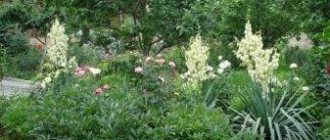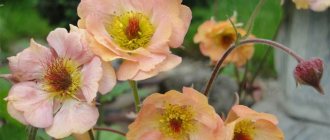Purity of petal color, beautiful shapes, rich aroma and increased vitality in different climatic zones - these are the criteria that all English roses of Austin selection meet. It was they who were guided by their creator, the British David Austin, when he wanted to remind the world about the undeservedly forgotten ancient rose bushes, and also to achieve continuous flowering.
Austin's creations have no official classification, but numerous varieties can be divided into several groups according to different characteristics. After all, when decorating personal plots, the type or height of the bushes is important for some, and the size of the flowers for others. And some gardeners just want to have some of the most beautiful roses in their garden.
Climbing varieties
Some varieties of Austin roses can be grown in the Russian climate as vines that will bloom along the entire length of the shoots. Among the best climbing representatives:
- Benjamin Britten (Benjamin Britten). Red-scarlet buds with a bright fruity aroma, which is dominated by wine, caramel and pear notes. Their size reaches 10-12 cm. Repeated flowering is observed throughout the season, in warm climates - three times. Bushes usually outgrow the 1 m mark stated in the description, and can reach 2 m or more. Flexible, prickly shoots, drooping under the weight of the inflorescences, are prone to thickening.
- Crown Princess Margareta (Crown of Princess Margareta). Tall Austin park roses with long shoots and dark green foliage. They are not afraid of low temperatures and most diseases. The variety is very healthy and hardy, even in harsh climatic conditions. The buds are particularly lush (up to 120 petals) and reach 10 cm when opened. Moreover, they do not bend to the ground even under the pressure of rain. Regular evening watering allows you to achieve the most abundant and long-lasting flowering.
Related article:
The main reasons for the death of young roses
- Gertrude Jekyll (Gertrude Jekyll). Densely leafy shrubs reaching a length of 3 m and a width of 1.85 m. 3-5 rich crimson flowers with paler edges are formed on the racemes. When opened, they reach 10 cm in diameter. The park variety is popular due to its frost resistance, ease of care, continuity and abundance of flowering. The latter can be further stimulated by removing old buds.
- Graham Thomas (Graham Thomas). One of the most popular varieties of Austin selection. It is distinguished by a very pure, rich yellow color, which usually becomes paler in the sun. Convex cup-shaped flowers, similar to peonies, have a pronounced sweet-tea aroma. They are formed on lashes 1.2-3 m long in an amount of 3-5 pieces and remain open for about 5 days. Bushes of average winter hardiness definitely need lashes tied to supports. Graham Thomas does not tolerate wet weather well and is affected by gray mold during such periods.
- The Pilgrim. Plants become climbing when grown on supports and reach three meters in length. Otherwise, they grow up to 90-120 cm and up to 90 cm in girth. Sometimes, towards the end of the season, they develop longer shoots that require pruning to maintain a beautiful bush shape. On each shoot with shiny, as if polished foliage, 1-3 buds of medium or large size are formed. They are characterized by an open rosette shape with small curling petals and a rich yellow hue with paler colors at the edge of the petals. Pilgrim is a re-blooming variety. It is well adapted to wintering in the Russian climate, but does not tolerate heavy rains.
How to choose and care
Seedlings can be purchased in stationary nurseries, rose gardens, and online stores. The cost will depend on the age of the seedling, the type of root system (closed or open), and the type of rootstock.
The “awning” rootstock is carried out on Rosa laxa (white roots), which does not produce wild growth if the plant is planted correctly. The Rosa canina (dog rose) rootstock produces a lot of growth that needs to be cut straight from the root.
Landing
When planting a plant, you need to follow certain steps:
- Choose high-quality material (preferably with a closed root system), based on reviews from trusted sellers.
- Choose a place – sunny, well-ventilated, spacious.
- Dig a hole (30-40 cm deep, 40-50 cm wide).
- Spill 4-5 liters of water until completely absorbed.
- Be sure to add a drainage layer (fine gravel, tile particles).
- Carefully distribute the earthen lump and cover it with nutritious soil.
- If the root system is closed, do not distribute the roots, plant them together with the lump.
- If the roots are without soil, cut them by a third, soak them in water, you can add a rooting agent to the water, or sprinkle them before planting.
The graft should cover 4-5 cm of soil. After planting, spill 3-4 liters of water.
Planting time is spring (warmed soil to +7-9⁰С), late April and early May for the Moscow region, middle zone. In warm regions, Crimea can be planted in the fall (mid-September to early November) - before the first frost (the plant should take root well).
Top dressing
In spring, nitrogen-containing fertilizer complexes are relevant - rapid growth of shoots and leaves. For good flowering - complexes containing potassium and phosphorus.
It is better to dissolve all fertilizers in water and pour them after abundant watering (the roots can burn if you do not water them before fertilizing). Stop feeding any species from August.
Under stressful conditions (lack of moisture, cold snap, heat, prolonged rains), sodium humate, epin, zircon can be used.
Trimming
It is advisable to prune (Russian conditions) in early spring, when you can see which shoots have frozen. Be sure to use sharp, high-quality pruning shears.
Trimming conditions:
- Cut out small, thin shoots.
- Remove all branches growing inside the bush.
- For a spreading bush, trim the ends (4-6 cm).
- Climbing look - keep the main long shoots, remove the internal, small ones.
- Compact - cut off two thirds, leaving 4-7 main shoots.
Re-tying buds - remove fading buds in time.
Detailed cutting instructions can be found on YouTube channels.
Additional care
Watering - 4-5 liters of cold water for each bush. The frequency of watering depends on the temperature and amount of precipitation (usually once every 7-10 days, in hot weather - once every 3-4 days).
Weeding and loosening with a radius of 25-30 cm are required. Can be covered with moss. mown grass in summer.
In winter - cover with spruce branches, after a temperature of -5⁰-7⁰С.
To prevent fungal (powdery mildew, spotting) diseases and aphid infestations, you need to use specialized preparations and folk remedies.
Reproduction
You can get larger quantities of a particular variety yourself using the main types of propagation:
- Cuttings - plant part of the shoot with buds (after spring pruning) in moist soil (greenhouse), use a rooting agent.
- Layerings - part of the lower branch is attached to the ground with a peg, sprinkled, left for 2-3 months, then cut off from an adult plant.
- Budding - an incision is made on the bark of the lower part, a part with a cultivated bud is inserted, experience is required.
Propagation of roses by seeds is not used due to poor germination of seeds over a long period of time.
The easiest way is cuttings, when in good conditions (warm and high humidity) the shoot gives roots.
Tall varieties
Provided good care, many ostina grown in central Russia are distinguished by greater growth compared to that indicated in the descriptions. Roses form tall bushes that do not require support. Among them are varieties such as:
- Golden Celebration. It owes its name to the rich yellow color with a copper tint, so unusual for Austin's English roses. From them, densely double cup-shaped flowers with a diameter of 8-14 cm bloom, attracting attention with a fruit and berry aroma. Round, spreading shrubs grow up to 120-150 cm, and in hot climates they can reach 200 cm as climbing crops. The stems are practically thornless, with up to 10 flower buds formed on each. Abundant flowering begins in summer and continues in waves until the end of the season.
Related article:
Park rose Morden Blush
- Lady Emma Hamilton (Lady Emma Hamilton). Neat plants growing up to 120 cm. Young shoots and leaves are characterized by a bronze color, which transforms into green as the plants develop. Inflorescences are formed from 3-5 buds. The latter, when closed, have a dark red color with orange splashes; when open, they become a bright tangerine color. The fruity-citrus aroma is especially strong between 9 and 11 am. Flowering begins in June and lasts all summer, but in rainy weather you will have to wait longer.
- Leander (Leander). Austin roses, growing up to 150-180 cm in height and up to 150 cm in girth. Against the background of shiny green leaves, the brushes formed from 5-10 pieces of small bright apricot buds stand out in contrast. Leander is considered a once-blooming plant, although single flowers may appear later.
- Spirit of Freedom. Shrubs with gray-green foliage reach a height of 120-150 cm and a girth of up to 120 cm. About 3 rosettes with dense, deep-set petals appear on the racemes formed on the shoots. They have a myrrh aroma with fruity notes. The traditional color is soft pink, sometimes lilac shades appear, size is 12-14 cm. Plants prefer sunny areas, are resistant to cold weather and practically do not get sick.
- William Morris (William Morris). Fast-growing upright shrubs reach 120-150 cm with a girth of about 90 cm. They are also suitable for growing on a support (subject to tying). On the shoots, densely double cup-shaped flowers of watercolor color are formed from a mixture of pale pink and apricot shades.
Related article:
Rose Deja Vu: description and characteristics of a hybrid tea variety
Plant care
Small garden roses - popular varieties
Caring for a rose bush does not take much time.
It is better to water in the evening, but the water should not be cold. After rain, it is advisable to shake off the water from the buds to avoid rotting. And the soil needs to be loosened periodically.
Only roses older than 1 year need feeding; such bushes must be fertilized from the beginning of flowering until mid-August, with an interval of 3-4 weeks.
- the first fertilizing should be nitrogen-containing fertilizers;
- the second - from organic and complex;
- the third - from potassium and phosphorus-containing.
Jude the Obscure
Proper pruning will allow the rose garden to bloom more than once during the summer; it should be done three times a season.
- The first - in the spring, before young leaves appear - weak and diseased shoots are removed.
- The second is all summer, the shoots must be pinched so that the bush becomes more luxuriant.
- And the third is preparation for winter. Dry and diseased branches, dry leaves and buds are removed.
If roses need to be replanted, it is recommended to do so after pruning, but replanting mature roses can be problematic as some varieties have roots that extend more than a meter underground.
Important! You can cover roses for the winter with earth or sawdust, after adding poison for rodents to prevent them from chewing on the roots.
Large-flowered varieties
Large, lush flowers are characteristic of most Austin roses. Moreover, more impressive sizes can be seen only several years after planting. In addition to the Golden Celebration and Spirit of Freedom mentioned above, these varieties include:
- Abraham Darby (Abraham Darby). Rounded bushes 120-150 cm high are highly resistant to frost and disease. They produce large (up to 12-15 cm) peach buds of the classic shape of ancient roses with a bright fruity aroma. The petals are decorated with pink, golden or copper shades, which appear depending on weather conditions: the first ones prevail in cold weather, the second and third ones - in hot weather. Flowering begins one of the first and continues continuously until late autumn.
- Jubilee Celebration. Considered one of the best among Austin roses. They got their name in honor of the golden jubilee of the Queen of England. Vigorous (120-130 cm) shoots are characterized by abundant and prolonged flowering until autumn frosts. The pink petals on the reverse side have a golden hue and exude a fruity scent with notes of lemon and raspberry.
- Lady of Megginch. The densely double crimson flowers collected in inflorescences are 12-14 cm in size. As they bloom, their shape changes from cup-shaped to rosette-shaped, and the color becomes dark pink. The stems, about 120 cm high, are abundantly covered with buds and bloom almost continuously, and are highly resistant to frost and disease. Lady of Meginch is suitable not only for growing in flower beds, but also for creating borders and hedges.
Related article:
Roses from autumn cuttings
- Princess Alexandra of Kent (Princess Alexandra of Kent). A continuously flowering bush variety with graceful stems drooping to the ground under the weight of large flowers. The latter are distinguished by a densely double structure, rich pink color of the petals with a lighter tier along the outer edge. Despite their large size (10-12 cm), they tolerate rain well and stay on the shoots for at least a week, gradually changing the intense aroma from fresh tea to lemon-currant. The average dimensions of plants are 100x100 cm.
- The Dark Lady. Austin's original bright crimson roses smell brightly of rose oil. They appear on the shoots one at a time or are collected in small brushes (up to 3 pieces). They have a terry, loose structure and, when fully opened, resemble tree-like peonies. Medium-sized (about 100 cm) bushes grow well with age and prefer sunny places or partial shade.
Reviews from flower growers
Galina, 34 years old, Uzhgorod
Of all the ostinas, I am most impressed by 'Graham Thomas' with its bright cup-shaped flowers of golden yellow color and the scent of tea roses. The bushes are erect, dense, highly branched. I do the pruning in the spring. To obtain a large spreading bush, I remove only the thinnest shoots, as well as frozen and damaged branches. It looks great next to 'Benjamin Britten' with its deep red flowers.
Margarita, 37 years old, Tuapse
“English women” create a wonderful harmonious ensemble in our garden. You can admire them from early summer until late autumn. My favorites: Lady of Shalott - a wonderful, trouble-free, hardy beauty, Jubilee Celebration - luxurious and incredibly fragrant, Gentle Hermione - profusely blooming and most delicate, Darcey Bussel - bright, not fading in the sun, Wollerton Old Hall - amazing and the latest.
Andrey, 49 years old, Belgorod region
I planted several Munstead Wood seedlings after I formed the rose garden. After a few years, it became clear that there is no special wisdom in caring for them, but the “awn” should be placed separately: they do not combine well with other varieties. The flowers are large, in the tradition of ancient roses, with purple velvety petals and a delicate fruity aroma. The bushes are very spreading and require a lot of space. So when purchasing, be sure to pay attention to the stated dimensions of the plant, its height and width.
For container growing
Compact Austin varieties do well in flowerpots and containers that can be placed, for example, at the entrance to the house. But for the winter they will have to be dug under a common shelter with garden roses. Here you should pay attention to the following names:
- Anne Boleyn (Anne Boleyn). Plants are 90-110 cm high and 80-100 cm wide with freely arranged arching shoots covered with soft green glossy foliage. Double rosette flowers (up to 10 cm in diameter) have a soft pink hue with a darker back side of the petals. Collecting in large inflorescences (up to 10 pieces), they appear regularly until late autumn.
Related article:
How to insulate a rose for the winter
- Christopher Marlowe (Christopher Marlowe). Dense spreading bushes with intertwining shoots grow up to 70-90 cm and have the same diameter. The medium-sized buds will become a real decoration in the garden thanks to their bicolor color, unusual for Austin roses: the inner rows of petals are orange-pink on the inside and golden-pink on the outside. They appear throughout the summer almost continuously. They have a tea aroma with lemon notes.
- Lady of Shalott. One of the best of Austin's English roses, especially for beginning gardeners. Branched shoots about 110 cm high are resistant to diseases and frost, hardy and capable of continuous flowering even in cold, rainy summers. On each stem, 1-3 buds of bright orange color appear. As the petals open, they take on a salmon-pink hue with a golden-yellow back, which is clearly visible due to their cupped shape. The rich aroma is reminiscent of apple blossom and cloves.
- Sophy's Rose (Soufiz Rose). The main feature of the densely double raspberry-purple buds is the gradually increasing size of the petals from the center to the edges, due to which wide, fairly flat flowers are formed. Usually they are collected in the form of small brushes of 3-5 pieces. Strongly branched bushes with a small number of thorns grow up to 90 cm, bloom profusely again, and are very resistant to disease.
- Queen of Sweden/Christina (Queen of Sweden/Christina). David Austin variety with neat small (about 7 cm) flowers of a soft pink color, sometimes with an apricot tint. Deeply cupped roses gradually open to cupped rosettes and smell of myrrh. Flowering resumes throughout the summer, but after rains the decorative effect is sometimes lost. Erect, well-branched bushes with a large number of sharp thorns usually grow no higher than 120 cm.
David Austin roses: general description
Roses bred at David Austin's nursery look reminiscent of ancient ones. This is due to the fact that David used Albu, Gallic, Bourbon and Damask roses to create them. But unlike them, most windows have the following advantages:
- a wide variety of colors;
- undemanding conditions of detention;
- formation of buds along the entire length of the shoot;
- abundant and repeated (or continuous) flowering throughout the entire growing season.
English roses can live in poor soils with short daylight hours. It is enough for them to have the sun shining on them for 4 to 5 hours during the day.
David Austin paid and continues to pay special attention to the shape and color of flowers. Each of his roses must have ideal outlines. He considered the most beautiful forms of roses to be:
- cup-shaped;
- rosette;
- peony-shaped.
If the roses resulting from crossing had a different bud shape, or their color could not be called “pure,” David ruthlessly rejected them.
Another distinctive feature of ostina is its strong alluring aroma. They may smell like lemon, myrrh, tea, musk or sweet fruits. There is not a single variety in Austin's collection that lacks a bright and juicy aroma.
In recent years, David Austin has been making strict selections, regretting that he previously spent time breeding insufficiently viable roses. Therefore, modern varieties are characterized by maximum resistance to fungal infections and frost, as well as other unfavorable conditions. Despite this, most flowers suffer from rain: in wet weather, the buds stop opening, and already blooming flowers lose their attractiveness.
This is interesting! David Austin is an English farmer who has dedicated his life to breeding the perfect variety of roses. The appearance of the first “ostina” was preceded by a trip to France, where David was struck by the extraordinary beauty of ancient roses. But they bloomed only once a year. Since then, he has been fighting this absurd mistake of nature. And it turned out to be successful: today the collection of David Austin roses includes more than two hundred varieties, blooming repeatedly or continuously. And the catalog of the eminent breeder continues to be replenished with new varieties names every year.
Diseases
Austin roses are susceptible to powdery mildew and black spot, so prevention and pest control is a must.
The main cause of rose damage is fungi. A solution of bicarbonate of soda is effective against powdery mildew, but it can burn out diseased areas of the leaves, which will not add beauty to the bush. Affected branches must be removed and burned; they cannot be used as compost.
Master Austin, as many call him, advises planting these flowers in combination with each other. Austin roses are worth the effort, they will decorate any garden with proper care. At the same time, it should be noted that even novice flower lovers will be able to choose a variety that suits their capabilities.
Reproduction methods and preparation for winter
Austin roses are bred in two ways - cuttings and layering:
- For cuttings, select fresh sprouts, cutting them so that each leaves three leaves. The landing site should be in the shade, well dug and free of weeds. Before the procedure, the two lower leaves are removed. The shoots are planted so that one top leaf remains on the surface. Then they are covered with cut-off plastic bottles with an open neck, which are sprinkled with snow at the beginning of winter. After a year, the young plants will take root and become stronger. In the spring they are replanted, preferably without exposing the roots, leaving more soil on them.
- Layerings are used only for mature plants. They select shoots, cut them at the bottom of the stem, press them to the soil with a staple, sprinkle them a little and begin to water them. If the sprout has taken root, after a year it can be transplanted and grown as an independent crop.
English roses do not tolerate frost well, so they must be carefully covered. If the temperature drops to minus 5 degrees, they begin to remove immature shoots along with the remaining leaves, and the plant itself is hilled up. A fence made of foam plastic or plywood is built around the bush; you can also use a plastic container. The internal space between the plant and the fence is filled with dried humus or foliage. Branched varieties are pinned to the ground and covered with a layer of foliage at least 30 cm thick. Crops can be opened after the air warms above 0 degrees Celsius.
Englishworts take root well both in pots and in open areas. Thanks to such a promising description, Austin roses are actively used in landscape design when creating flower beds in the garden and mixborders (a flowerbed with many different flowers). Some experts use climbing varieties to build hedges.
Bloom
The flowering period for ostina begins in June, with a second wave occurring at the end of August.
A special feature of care during flowering is to protect the buds from excessive humidity and scorching sun. After the roses have bloomed, the buds must be removed.
It happens that a rose does not bloom even in the second year after planting. This may be caused by poor site selection or pruning, overgrowth or improper care. In any case, we need to take a closer look at the reason. It is advisable to remove small shoots and fertilize the bush with potassium supplements or humate with microelements.











